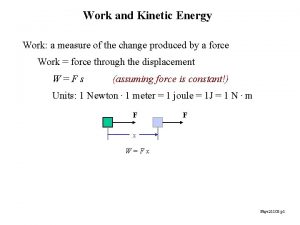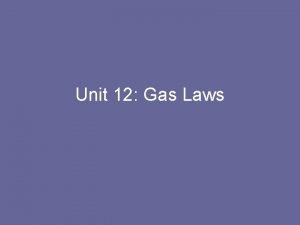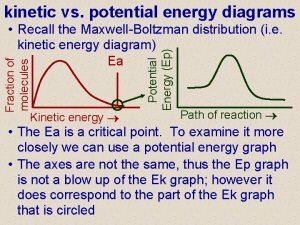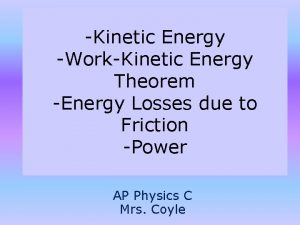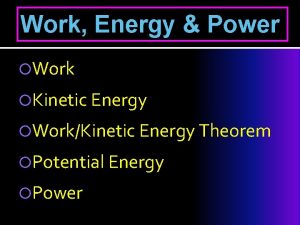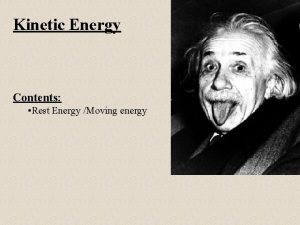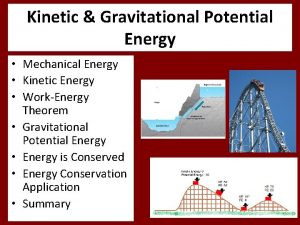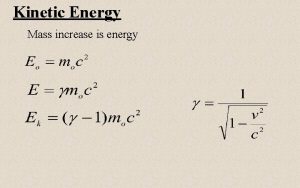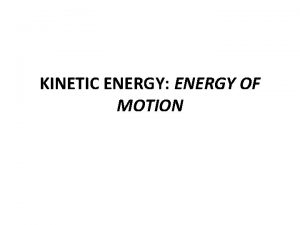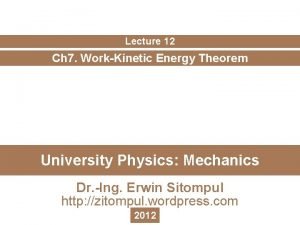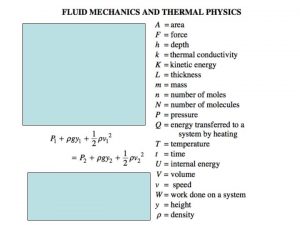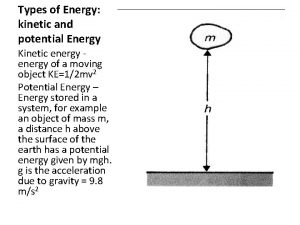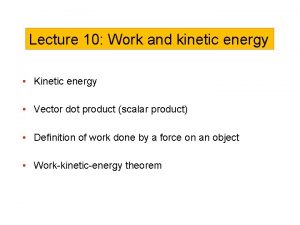5 2 Kinetic Energy and the WorkKinetic Energy






















- Slides: 22

5. 2 Kinetic Energy and the Work-Kinetic Energy Theorem d F Vi F Vf = V Given Wnet we can solve for an object’s change in velocity

d F vi Wnet = F d Wnet = (m a) d Wnet = m (v 2 - vi 2) / 2 Wnet = 1/2 m v 2 - 1/2 m vi 2 F vf = v v 2 = vi 2 + 2 a d = (v 2 - vi 2) / 2 Kinetic Energy = KE = (1/2) m v 2 Wnet = KEf – KEi = delta KE

5. 2 Kinetic Energy and the Work-Kinetic Energy Theorem Objects with KE can do work on other objects The more KE object A has, the more work it can do on object B Remember, b/c Newton’s 3 rd law, when object A does work on object B, object B also does work on object A

Checking for comprehension Two football players are going to sack the QB. Player 1 has a mass of m and has a velocity of v. Player 2 has a mass of ½ m and has a velocity of 2 v. Who is more likely to cause serious injuries to the QB? Why? Ans: the less massive guy b/c…. He has more KE

Example Problem: A 1400 kg car has a net forward force of 4500 N applied to it. The car starts from rest and travels down a horizontal highway. What are its kinetic energy and speed after it has traveled 100 m? (Ignore the losses in KE because of friction and air resistance. ) Solve using Work-KE theorem and kinematic equations

5. 3 Potential Energy Objects with KE can do work on another object What about objects sitting still? They have the potential to do work Therefore they have potential energy

5. 3 Potential Energy Gravitational potential energy: the energy that an object has as a result of its position PE = mgh Wg = mghi - mghf Wg = PEi – PEf = - delta PE

1 kg 1 m 1 m Mr Gener: “What is the PE of the block? ” You: “Depends… Where does h = 0? ” Because location of h = 0 point is arbitrary, we need only to concern ourselves with the difference in PE between two locations

Example: A 60. 0 kg round guy is at the top of a slope. At the initial point A the round guy is 10. 0 m vertically above point B. a) Setting h = 0 at B, solve for the PE of the guy at A then B and then find the difference b) Setting h = 0 at A, solve for the PE of the guy at A then B and then find the difference Ans: delta PE = 5880 J. . Regardless of where h = 0

Homework: Sections 5. 2 – 5. 3 Page 142, Problems 9, 11, 14, 21

5. 4 Conservative and Nonconservative Forces Conservative force: the work it does on a object moving between two points is independent of the path the object takes between the two points Example: gravity A force is nonconservative if it leads to the dissipation of KE or PE (mechanical energy) Example: friction

5. 5 Conservation of Mechanical Energy The total mechanical energy in any isolated system remains constant if the objects interact only through conservative forces Wnet = Wc = Wg = PEi - PEf Wnet = KEf - KEi = PEi - PEf KEi + PEi = KEf + PEf ½ mvi 2 + mghi = ½ mvf 2 + mghf

Checking for comprehension: Block 1 2 vi Block 2 v i h h Two blocks, of the same mass, are 2 h above the ground. Block 1 has an initial velocity of 2 vi downward and block 2 has an initial velocity of vi upward a) Which block has more mechanical energy? 1 b) How would your answer change if block 1 started off only h above the ground? Not enough info

Example 5. 5: A sled and its rider together weight 800 N. They move down a frictionless hill through a distance of 10. 0 m. Assuming the initial speed of the rider-sled system is 5. 00 m/s down the hill, solve for the speed of the rider-sled system at the bottom of the hill? vi = 5. 00 m/s 10 m

Homework: Section 5. 4 – 5. 5 Page 142 -143, Problems 23, 25, 27, 29

5. 6 Nonconservative Forces and the Work-KE Theorem Remember Wnet = KEf - KEi Wnet = Wc+Wnc = KEf - KEi Wc = PEi - PEf Therefore: Wnc = KEf – KEi – (PEi – PEf) Wnc = (KEf + PEf) – (KEi + PEi)

5. 6 Nonconservative Forces and the Work-KE Theorem Wnc = (KEf + PEf) – (KEi + PEi) The work done by all nonconservative forces equals the change in the mechanical energy of the system The mechanical energy lost from the system is transformed into another form of energy such as sound, light or heat

Example Problem: A 3. 00 kg create slides down a ramp. The ramp is 1. 00 m long and inclined at an angle of 30. 0 o. The crate starts from rest at the top of the ramp, experiences a constant frictional force of magnitude 5. 00 N, and continues to move a short distance on the flat floor. Use energy methods to determine the speed of the crate when it reaches the bottom of the ramp. What happened to the energy lost due 1 m to friction? 30 o

Things to remember: ΣW = (F d) if F and d are parallel KE = ½ mv 2 PE = mgh For conservative forces: KEi + PEi = KEf + PEf Wnet = Wc + Wnc = ½ mvf 2 - ½ mvi 2 If mechanical energy is lost, the lost energy must have been transformed into another form of energy such as heat, sound or light

5. 8 Power is defined as the time rate of energy transfer Powerave = W / (Δt) = (F Δx) / Δt = F (Δx / Δt) =Fv Units for Power is J/s or watts

Example problem: An elevator of mass M carries a max load of mass m. A constant frictional force of Ff retards its motions upwards. What is the minimum power that the motor must deliver to lift the fully loaded elevator at a constant speed of v? a = 0 m/s 2 Ft – Ff – (M+m)g = 0 Ft v mg Ff Ft = Ff + (M+m)g P = F v = Ft v = [Ff + (M+m)g]v

Homework: Section 5. 6 – 5. 8 Page 144 -145, Problems 33, 37, 39, 41, 43
 Example of kinetic energy
Example of kinetic energy Potential energy of spring
Potential energy of spring Formula of potential energy
Formula of potential energy Conservation of mechanical energy
Conservation of mechanical energy Define kinetic energy
Define kinetic energy Total energy formula
Total energy formula Gravitational potential energy vs kinetic energy
Gravitational potential energy vs kinetic energy Mass and thermal energy
Mass and thermal energy What is kinetic and potential energy
What is kinetic and potential energy Kinetic energy from acceleration
Kinetic energy from acceleration Ads=vdv example
Ads=vdv example Relation between pressure and kinetic energy of gas
Relation between pressure and kinetic energy of gas Kinetic and potential energy
Kinetic and potential energy Kinetic and potential energy graphic organizer
Kinetic and potential energy graphic organizer Kinetic and potential energy
Kinetic and potential energy Examples of kinetic energy
Examples of kinetic energy Potential energy
Potential energy Epgraph
Epgraph Lesson 2 kinetic and potential energy answer key
Lesson 2 kinetic and potential energy answer key Kinetic energy magnetic field
Kinetic energy magnetic field Grade 7 term 3 natural science
Grade 7 term 3 natural science Kinetic and potential energy: jumping frogs answer key
Kinetic and potential energy: jumping frogs answer key Which statement best compares momentum and kinetic energy?
Which statement best compares momentum and kinetic energy?









